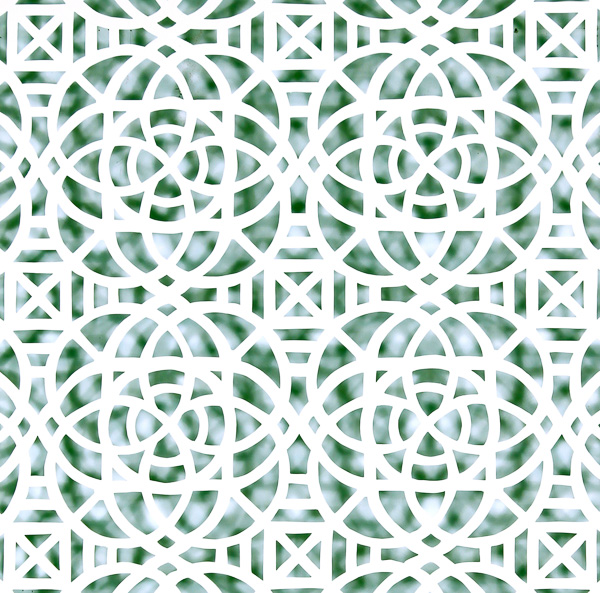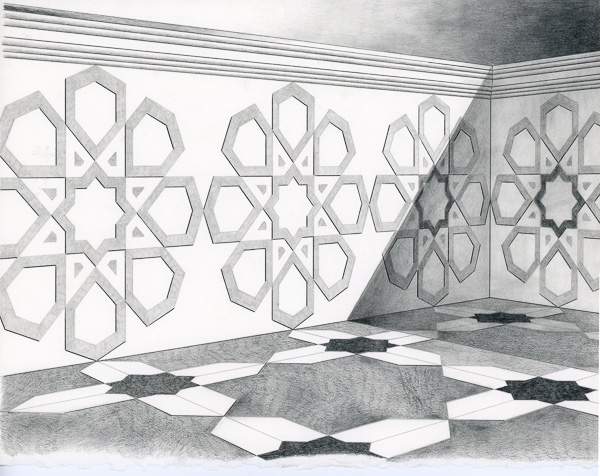Since ancient times, geometric perfection has been thought to convey sacred and secular truths by reflecting the fractal interconnections of the natural world. The artists in “Geometric Aljamía: A Cultural Transliteration” explore geometry as a fundamental aspect of art and as a way to communicate universal ideas across cultures.
The mixed-media exhibition is on display Oct. 25 through Dec. 2 in The Gallery at Penn College. An artist talk is set for 5 p.m. on Thursday, Nov. 10, in the gallery on the third floor of The Madigan Library at Pennsylvania College of Technology. Admission to the gallery is free and open to the public.
 A workshop, “Motif Design & Papercutting Workshop,” will also be offered from 9 a.m. to 4 p.m. Thursday, Nov. 10, for a cost of $20. Registration is required as space is limited. The workshop will provide an overview of sacred geometry and a brief history of papercutting across cultures. Participants will design motifs inspired by sacred geometry that will be used to create unique papercuts or colorized grid patterns. Tessellation, mirror imaging and tiling will be investigated.
A workshop, “Motif Design & Papercutting Workshop,” will also be offered from 9 a.m. to 4 p.m. Thursday, Nov. 10, for a cost of $20. Registration is required as space is limited. The workshop will provide an overview of sacred geometry and a brief history of papercutting across cultures. Participants will design motifs inspired by sacred geometry that will be used to create unique papercuts or colorized grid patterns. Tessellation, mirror imaging and tiling will be investigated.
The workshop instructor is Reni Gower, professor emerita of painting and printmaking, Virginia Commonwealth University. She holds a Master of Fine Arts from Syracuse University. Gower is among the six artists exhibiting in “Geometric Aljamía.”
“Aljamía” is a medieval Spanish word that refers to Romance languages written in Arabic script. This transliteration contributed to the dissemination of the Arabic language and Islamic influences throughout the Iberian Peninsula and beyond. By understanding the visual arts as a transliteration of one form of thinking to another and addressing the fundamental patterns embedded in visual art, “Geometric Aljamía” revisits the ongoing impact of Islamic art, science and philosophy throughout the world today.
Papercut installations in the exhibition use sacred geometry to blend subtle imperfection with structured repetition. Wall tracings and motifs are inspired by Islamic tilework, Koran illumination tezhip patterns in the Ottoman style, and Islamic miniatures attributed to the Behzād illumination style. In the drawings, linear perspective is employed as a metaphor for Western civilization. The shared artistic and intellectual interests of the artists speak to the larger hybrid relationship that the West shares with the Middle East and, especially, with the Islamic Golden Age.
 By addressing the fundamental geometry embedded in two-dimensional art, “Geometric Aljamía” acknowledges hybrid connections among Europe, the Mediterranean Basin and the Middle East. One finds these similarities across cultures embedded in many diverse ethnic patterns. Incorporating these patterns into works of art promotes access through recognition, and this commonality creates a connection. Geometric ornamentation may have reached a pinnacle in the Islamic world, where it has been assimilated into all aspects of everyday life. This exhibition examines an extended cross-cultural integration of the arts into life.
By addressing the fundamental geometry embedded in two-dimensional art, “Geometric Aljamía” acknowledges hybrid connections among Europe, the Mediterranean Basin and the Middle East. One finds these similarities across cultures embedded in many diverse ethnic patterns. Incorporating these patterns into works of art promotes access through recognition, and this commonality creates a connection. Geometric ornamentation may have reached a pinnacle in the Islamic world, where it has been assimilated into all aspects of everyday life. This exhibition examines an extended cross-cultural integration of the arts into life.
The Gallery at Penn College is open 2 to 8 p.m. Tuesdays, Wednesdays and Thursdays; 10 a.m. to 4 p.m. Fridays; and 1 to 5 p.m. Sundays. The gallery will also be open 1 to 5 p.m. Saturday, Oct. 22, during Wildcat Weekend. (The gallery is closed on Mondays, Saturdays and during college holidays and breaks, including Nov. 23-28.)
Serving as a cultural asset to the college and local communities, The Gallery at Penn College provides the opportunity for the appreciation and exploration of contemporary art and encourages critical thinking and meaningful experiences.
For more about the gallery or to register for the workshop, email or call 570-320-2445.
For more about Penn College, a national leader in applied technology education, email the Admissions Office or call toll-free 800-367-9222.
The mixed-media exhibition is on display Oct. 25 through Dec. 2 in The Gallery at Penn College. An artist talk is set for 5 p.m. on Thursday, Nov. 10, in the gallery on the third floor of The Madigan Library at Pennsylvania College of Technology. Admission to the gallery is free and open to the public.
 A workshop, “Motif Design & Papercutting Workshop,” will also be offered from 9 a.m. to 4 p.m. Thursday, Nov. 10, for a cost of $20. Registration is required as space is limited. The workshop will provide an overview of sacred geometry and a brief history of papercutting across cultures. Participants will design motifs inspired by sacred geometry that will be used to create unique papercuts or colorized grid patterns. Tessellation, mirror imaging and tiling will be investigated.
A workshop, “Motif Design & Papercutting Workshop,” will also be offered from 9 a.m. to 4 p.m. Thursday, Nov. 10, for a cost of $20. Registration is required as space is limited. The workshop will provide an overview of sacred geometry and a brief history of papercutting across cultures. Participants will design motifs inspired by sacred geometry that will be used to create unique papercuts or colorized grid patterns. Tessellation, mirror imaging and tiling will be investigated.The workshop instructor is Reni Gower, professor emerita of painting and printmaking, Virginia Commonwealth University. She holds a Master of Fine Arts from Syracuse University. Gower is among the six artists exhibiting in “Geometric Aljamía.”
“Aljamía” is a medieval Spanish word that refers to Romance languages written in Arabic script. This transliteration contributed to the dissemination of the Arabic language and Islamic influences throughout the Iberian Peninsula and beyond. By understanding the visual arts as a transliteration of one form of thinking to another and addressing the fundamental patterns embedded in visual art, “Geometric Aljamía” revisits the ongoing impact of Islamic art, science and philosophy throughout the world today.
Papercut installations in the exhibition use sacred geometry to blend subtle imperfection with structured repetition. Wall tracings and motifs are inspired by Islamic tilework, Koran illumination tezhip patterns in the Ottoman style, and Islamic miniatures attributed to the Behzād illumination style. In the drawings, linear perspective is employed as a metaphor for Western civilization. The shared artistic and intellectual interests of the artists speak to the larger hybrid relationship that the West shares with the Middle East and, especially, with the Islamic Golden Age.
 By addressing the fundamental geometry embedded in two-dimensional art, “Geometric Aljamía” acknowledges hybrid connections among Europe, the Mediterranean Basin and the Middle East. One finds these similarities across cultures embedded in many diverse ethnic patterns. Incorporating these patterns into works of art promotes access through recognition, and this commonality creates a connection. Geometric ornamentation may have reached a pinnacle in the Islamic world, where it has been assimilated into all aspects of everyday life. This exhibition examines an extended cross-cultural integration of the arts into life.
By addressing the fundamental geometry embedded in two-dimensional art, “Geometric Aljamía” acknowledges hybrid connections among Europe, the Mediterranean Basin and the Middle East. One finds these similarities across cultures embedded in many diverse ethnic patterns. Incorporating these patterns into works of art promotes access through recognition, and this commonality creates a connection. Geometric ornamentation may have reached a pinnacle in the Islamic world, where it has been assimilated into all aspects of everyday life. This exhibition examines an extended cross-cultural integration of the arts into life.The Gallery at Penn College is open 2 to 8 p.m. Tuesdays, Wednesdays and Thursdays; 10 a.m. to 4 p.m. Fridays; and 1 to 5 p.m. Sundays. The gallery will also be open 1 to 5 p.m. Saturday, Oct. 22, during Wildcat Weekend. (The gallery is closed on Mondays, Saturdays and during college holidays and breaks, including Nov. 23-28.)
Serving as a cultural asset to the college and local communities, The Gallery at Penn College provides the opportunity for the appreciation and exploration of contemporary art and encourages critical thinking and meaningful experiences.
For more about the gallery or to register for the workshop, email or call 570-320-2445.
For more about Penn College, a national leader in applied technology education, email the Admissions Office or call toll-free 800-367-9222.
